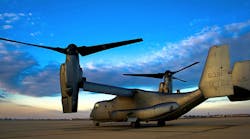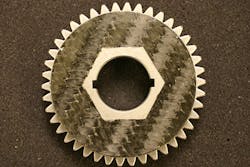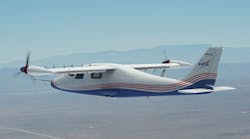NASA isn’t the first place you’d think of to solve terrestrial flight quandaries, but Robert Handschuh, branch manager for NASA Glenn Research Center’s rotating and drive systems department, has been pushing gear technology for military helicopters and other rotorcraft to new heights.
NASA tested face gears for the Apache attack helicopter in cooperation with Boeing. This resulted in a power increase from 2,800 to 3,400 horsepower. Now Handschuh and colleague Gary D. Roberts, a composites specialist at the Ohio research hub, have created a hybrid gear that could potentially shed several pounds off other advanced rotorcraft drive systems, such as the V-22 Osprey Tiltrotor's.
The NASA engineers, funded with only $50,000 in seed money for the small-scale prototype (as shown below), machined the metal out of an existing gear’s midsection, leaving only the teeth and shaft.
Then they filled in the machined-out portion with several layers of pre-impregnated carbon fiber (meaning the epoxy is already on it), then pressed and cured it in an oven.
The result was a 20% lighter gear that stood up to a billion cycles (10,000 rotations per minute over 69 days) in a small test rig. Noise and vibrations from the gears meshing are also reduced as the path from the teeth to the shaft is interrupted.
“Where’s this really gonna’ pay off?” Handschuh asks. “When stuff gets big.”
As far as rotors are concerned, It doesn’t get much bigger than the V-22. The first of its kind, the tiltrotor vertically takes off and lands like a helicopter and matches a turboprop airplane in range, speed, and altitude.
It executes troop transports, medivacs, and resupplies, so there’s no room for superfluous weight. Its lightweight composite airframe already promotes better fuel economy and is a major reason it can carry two dozen combat troops within a 428-nautical mile mission radius.
“One pound is a big deal to them, and every pound makes a difference, for payload, bullets, whatever the cargo is,” Handschuh explains. “If you could save 50 pounds out of an aircraft, they’ll probably have a shrine for you at one of the helicopter companies.”
The Osprey’s gearboxes comprise up to 15% of the multi-mission aircraft’s total weight. Because the preliminary test gear cuts at least 20%, the eventual weight loss could reach much more than 50 pounds. How much exactly is still an unknown.
“These were not designed to be the lightest,” says Roberts of the prototypes lying around the lab.
Roberts estimates that the composite could make a gear 50% lighter “depending on how aggressive we are.”
“What we really needed to do was get this composite material and the adhesive that was used inside a gearbox running long endurance test in hot oil,” Roberts explains, “because that’s an exposure that composites don’t normally see. We didn’t see any failures.”
The Glenn team wanted to stress test the composite gear even further, so they inserted the composite gear in a testing rig similar to the V-22’s to see how it would fare.
“We subsequently tortured them,” Handschuh says. “We wanted to see how much torque the prototype gears could take without breaking. It was about 10 times what you’d normally put through the gear from a contact fatigue standpoint.”
The radial separating forces eventually pushed the ring in, and “caused the composite to pucker out axially,” he says. “It was pretty strong though.”
The team is currently fielding offers to commercialize the gears.
Some companies have already expressed interest in the prototype, which would require the signing of a Space Act Agreement for commercialization. Roberts speculates that along with rotorcraft, heavy trucking, wind turbines, large industrial equipment, and mining operations could all make use of the lightweight gears, which would be able to be manufactured for any complex gear geometry.
Virtually anything with a gearbox for any application where fuel economy is needed would benefit, Roberts concedes.














